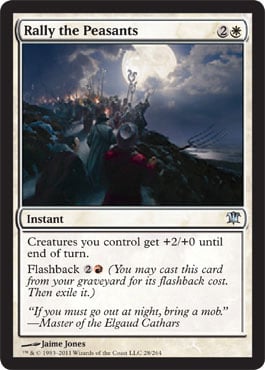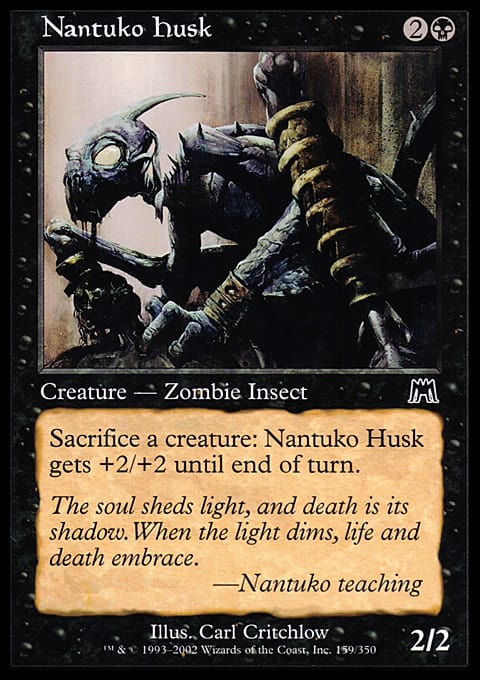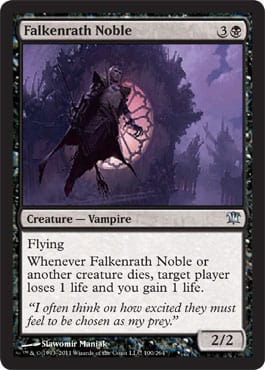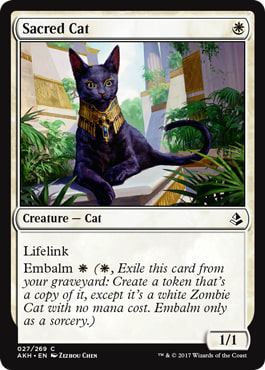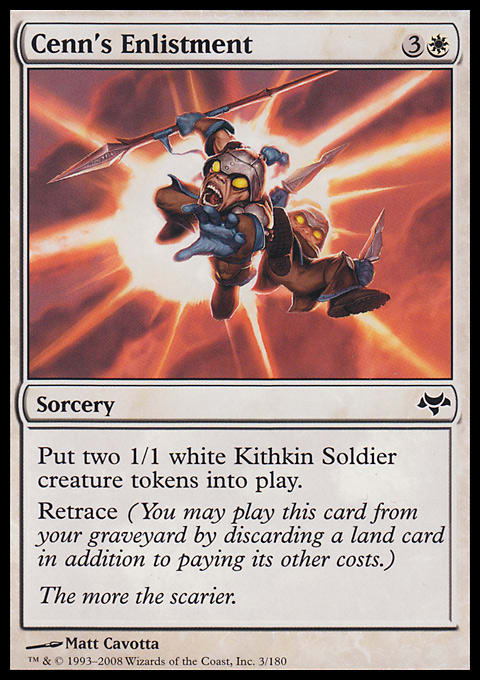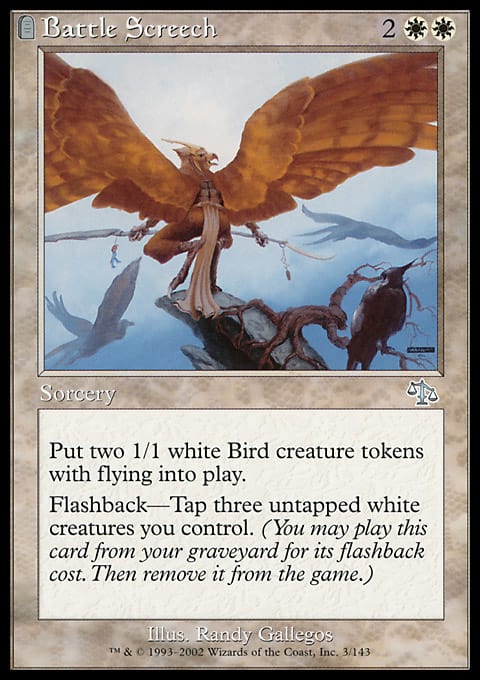Last week I talked about my latest obsession in Pauper — Orzhov Aristocrats. I spent a significant amount of time talking about the history of the deck but I spent a scant few lines talking about how the deck played. Today, I hope to explain more about the deck and how I perceive it in the metagame.
Orzhov Aristocrats ? Pauper | Alex Ullman
- Creatures (27)
- 2 Nantuko Husk
- 2 Safehold Elite
- 3 Falkenrath Noble
- 4 Carrion Feeder
- 4 Doomed Traveler
- 4 Sacred Cat
- 4 Sultai Emissary
- 4 Thraben Inspector
- Instants (7)
- 1 Harsh Sustenance
- 2 Rally the Peasants
- 4 Raise the Alarm
- Sorceries (5)
- 2 Read the Bones
- 3 Battle Screech
- Lands (21)
- 1 Mountain
- 7 Plains
- 7 Swamp
- 1 Boros Garrison
- 1 Rakdos Carnarium
- 2 Ash Barrens
- 2 Scoured Barrens
- Sideboard (15)
- 1 Cenn's Enlistment
- 1 Harsh Sustenance
- 2 Journey to Nowhere
- 2 Lumithread Field
- 2 Prismatic Strands
- 2 Tithe Drinker
- 2 Wail of the Nim
- 3 Standard Bearer
At its core, this is a tokens deck. Token decks, in Pauper, are aggressive strategies focused almost exclusively on going wide — that is putting a large number of bodies onto the battlefield. Like other beatdown decks, these want to operate on an efficiency of cost. Unlike a more traditional aggro build, Token builds care less about the specific cost to power ratio and more about the cost to body ratio.
A card like Nettle Sentinel is a good example of a solid creature for a beatdown deck. It has two power for a single mana and under most game conditions has no drawback. Raise the Alarm may not cost a single mana, but it produces two power across two bodies. While Stompy, with its Nettle Sentinels, likes to go tall with Rancor and Vines of Vastwood, Token decks use their army to go wide with force multipliers like Rally the Peasants.
No one threat in an average token based deck is going to win the game. The creatures are just too small. Instead they tend to win via swarms and anthems. Token decks also are less susceptible to singular removal spells. Currently, Pauper revolves around Skred and Lightning Bolt, with Chainer's Edict lingering not far behind. The ability to produce multiple threats from a single card makes it so that the removal spells matter less. While not everything is a Raise the Alarm, cards like Sacred Cat, Doomed Traveler, Safehold Elite, and Sultai Emissary all have the opportunity to make another creature upon their death. Two creatures from a single card means that eventually you can exhaust and opposing set of answers. But this is only one line of attack. Rally the Peasants and Harsh Sustenance make it so that the more threats on the table the better each one becomes. Falkenrath Noble makes it so that you can win without attacking for damage. The opportunity to handle the last few life points simply by forcing them to block from the threat of Rally the Peasants opens up an entirely different angle of attack.
Of course the deck can also simply go tall and build up a massive Carrion Feeder or one shot with a Nantuko Husk. Unlike other token decks, the Aristocrats can win from a variety of angles. This is a massive opportunity for the deck as it lets the pilot pivot plans without giving up much value.
The Aristocrats can play like a Token deck. It wants to do this against decks that cannot keep up with its threat production. In these games it wants to flood the board and eventually win with Rally the Peasants or Harsh Sustenance. More often than not this is the default mode of play and I will start most games with this plan in mind.
That is all well and good until my opponent starts acting. Once I have an idea of their path to victory, I can attempt to circumvent it with shortcuts of my own. Often this will involve burning a win condition early in order to create opportunities for other haymakers to have an increased impact later in the game. When I find myself facing down multiple copies of Augur of Bolas early, I have no qualms about spending a Rally to take out their blockers confident in knowing I will draw another game ender later.
Sequencing your creatures correctly is one of the best ways to gain a tiny edge with the deck. Against an unknown opponent, I would rather lead with Thraben Inspector than any other creature. If I know my opponent is on a Skred deck I am okay leading with Doomed Traveler. If I know they are on Spellstutter Sprite, I like to hold Sacred Cat for a turn where they have access to Sprite mana. Forcing them to spend a Sprite on half of a Cat helps us to eke out a small advantage.
Back to the 1-drops, I do not like playing out a Carrion Feeder unless I can extract some value from it. I like to have at least two other creatures on the table before committing a Feeder to the board, but I have no such qualms for Nantuko Husk. This is because Husk is a serviceable, if unexciting, threat on its own.
The hardest thing I have had to learn with this deck is when to cast creatures before combat and when to cast them after. Often you want to play them out before you attack especially if you have a Falkenrath Noble or a sacrifice outlet on the table. Casting Noble itself is also a tough nut to crack as sometimes you want to make sure it resolves but also would be better suited to have it in play for combat. A lot of this is going to come down to reading your opponent and understanding the mostly likely answer for them to have.
One of the more interesting elements of the deck is Sultai Emissary. I was initially skeptical of the inclusion, but the Manifest Zombie has proven its worth many times over. Not only can it surprise in a Falkenrath Noble or a Nantuko Husk, it also has synergy with the Flashback spells in the deck. Being able to turn your dead creature into a Battle Screech or attack in with an army and have a surprise Rally the Peasants at the ready, even while empty handed, gives you a massive strategic advantage. Similarly, the ability to sneak in a Prismatic Strands post-board can be a game changing swing. Finally, you can sometimes just have a Lumithread Field available at the ready, for no additional investment.
The Aristocrats is a deck that rewards practice and understanding matchups correctly. Full disclosure: you are going to be hard pressed to beat any deck’s perfect draw. While explosive, the Aristocrats does take some time to set up and the first few turns are loaded with undersized creatures. Against the average draws of the field this is often enough to survive to a winning position. Facing down blind-flipped double Delver, turn three Myr Enforcers, or chained copies of Burning-Tree Emissary on turn two, it is going to take some tight play to survive. But the deck thrives when everyone is playing to their mean. Keep this in mind as I discuss the matchups.
Izzet Delver is an even matchup and, considering the strength and prevalence of the deck, I feel that gives the Aristocrats an advantage. Normally the deck will start out as the aggressor, but you will have to reevaluate your position every turn. Sacred Cat is at its best early as a way to fight Skred and Spellstutter Sprite while Carrion Feeder is ever so slightly worse than normal.
Your goal here is to try and choke their mana and produce too many threats for them to handle easily. Casting Raise the Alarm on their upkeep is one way to do this, or casting multiple small creatures in the same turn. This is the matchup where burning an early Rally is great as it can reduce their resources to the point where they cannot recover. Attacking with Doomed Traveler is a great way to get in some extra damage as they often cannot abide giving you a flying blocker.
In sideboarded matches, it is tempting to bring in Wail of the Nim. I believe this is incorrect as it does not handle any of their most threatening cards. Instead, cutting a Carrion Feeder for Cenn's Enlistment gives you a longer game. If you fear Swirling Sandstorm, then make space for a copy or two of Prismatic Strands, potentially cutting a Safehold Elite and Falkenrath Noble. Affinity is a matchup where I feel the deck is at a disadvantage only because they can assemble a nut draw with some ease. Against one or two 4/4 bodies, you can muster enough defense to survive until the victory formation. Block aggressively to preserve your life total. Falkenrath Noble turns your chumps into an offense and it is easier for you to muster enough pings to eventually win. Sacred Cat does work against the machine as it can slowly put your life total out of reach of Atog and Fling. Very slowly. Here you are less likely to win with a Rally draw and should be fine casting it early if it means some profitable trades.
Sideboard games are about Harsh Sustenance and Falkenrath Noble. Cutting a Battle Screech, Carrion Feeder, and a Rally for the second Sustenance and the two copies of Journey to Nowhere give you a better chance to handle their Atogs. Cutting Read the Bones is enticing but the two life points rarely matter since Affinity is likely to win by more than two points of life and the raw cards provided will be more important.
Stompy is one of the top three decks I most want to face. The Aristocrats blocks exceedingly well and can preserve its life total until it can go over the top with Battle Screech and Rally the Peasants. Carrion Feeder is not at its best here as sometimes you really need to block.
Falkenrath Noble, however, shines as it presents a threat that is hard for Stompy to answer, even in games two and three.
Once you can cut Read the Bones and Raise the Alarm for Harsh Sustenance, Standard Bearer, and Prismatic Strands, it becomes incredibly hard for Stompy to punch through. Your sideboard outclasses their deck and makes it easier for you to win combats. If I am on the play, I will consider siding out a Carrion Feeder or two for Tithe Drinkers. On the draw, I might side out one Feeder and one copy of Battle Screech as a hedge against Scattershot Archer. Tithe Drinker is a fine blocker that helps to keep you alive.
Red decks, like Burn, Red Deck Wins, and Izzet Blitz, all hinge on an early copy of Sacred Cat. The ability to buff your life total while either chump blocking or attacking makes it harder for these archetypes to deal their final points. Prismatic Strands and Tithe Drinker are must haves here and will come in for Read the Bones and Raise the Alarm (against Burn and Izzet Blitz) or Carrion Feeder (against Red Deck Wins). The goal, always, is to survive. Sometimes you will want to bring in a second copy of Harsh Sustenance just to make sure you can keep a healthy number of life points.
The last decks I want to talk about today are the various ![]()
![]() decks. Dimir Flicker, Dimir Delver, and Dimir Alchemy, all have access to Shrivel, Counterspell, and Chainer's Edict. This combination is troubling as it can answer many of our paths to victory. Here the game plan is to survive long enough until one of the haymakers comes online and wins the game. The combination of removal and counters makes this easier said than done. Unlike other matchups you cannot just blindly commit threats to the board. Instead you have to be judicious. These games often come down to one point of life so missing it is critical.
decks. Dimir Flicker, Dimir Delver, and Dimir Alchemy, all have access to Shrivel, Counterspell, and Chainer's Edict. This combination is troubling as it can answer many of our paths to victory. Here the game plan is to survive long enough until one of the haymakers comes online and wins the game. The combination of removal and counters makes this easier said than done. Unlike other matchups you cannot just blindly commit threats to the board. Instead you have to be judicious. These games often come down to one point of life so missing it is critical.
Once you have access to your sideboard you want to bring in Lumithread Field and Cenn's Enlistment. The first makes Shrivel worse while the second helps to reduce the efficacy of removal. Harsh Sustenance is worse here but the other two come down to exactly what you are playing against. Most often the cut is Sacred Cat but sometimes you will leave it in against Dimir Delver if you feel the matchup turns into a race. Gurmag Angler, thankfully, is not that dangerous, much for the same reason Myr Enforcer isn’t — you are excellent at blocking.
I still believe the Aristocrats is a solid choice in Pauper. It provides a depth of play that can be rewarding for skilled pilots. The multitude of win conditions also makes it so that you can choose your own adventure as you dink and dunk to victory.
















